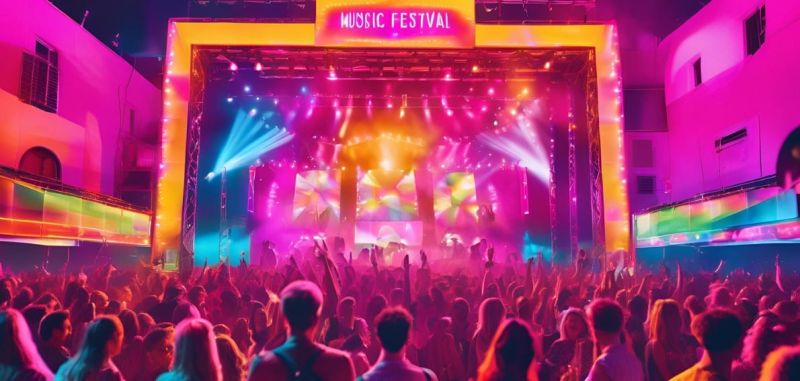Planning a music festival in 2025 requires an innovative approach that blends creativity with logistical expertise, while embracing the latest trends in technology, sustainability, and audience engagement.
The festival landscape has evolved over the years, and today’s organizers face unique challenges such as rising environmental concerns, the integration of cutting-edge technology, and catering to an increasingly diverse and demanding audience. Attracting event attendees through innovative marketing strategies, including multi-channel promotion and early buzz generation, is crucial for a successful turnout.
Whether you’re organizing an intimate gathering or a massive multi-day event, this guide will walk you through every step needed to create a successful and unforgettable music festival in 2025. The goal is to create an unforgettable event by blending cultural celebrations with the music festival, ensuring a remarkable experience for all attendees.
1. Establish Your Vision and Theme
Before diving into the logistics, it’s essential to establish your festival’s vision and theme.
Your festival’s identity will shape everything from its lineup to marketing strategies, venue selection, and overall atmosphere. A clear vision will help distinguish your festival from others and give it a cohesive identity.
Define Your Audience: Consider the demographics, preferences, and cultural trends of the crowd you want to attract. Are you targeting EDM lovers, indie rock fans, or jazz enthusiasts? Understanding your target audience will guide the rest of your planning process.
Choose a Unique Theme: A compelling theme adds an extra layer of excitement. It could range from an eco-friendly focus (zero-waste, sustainability), to celebrating a particular genre (e.g., a country music festival) or cultural movement (such as a hip-hop festival).
Mission and Values: If your festival has a social or environmental goal, such as promoting sustainability or inclusivity, make sure this mission is integrated into every aspect of your event planning.
Set Clear Festival Goals: Establishing clear festival goals early in the planning process is crucial. These goals will guide the event’s overall direction, budget allocation, and help define the festival’s purpose. Ensuring that objectives are specific and measurable can influence various aspects of the event’s success.
2. Budget Planning and Financial Strategy

Music festivals require substantial investment.
One of the first steps is creating a budget that accounts for every aspect of your festival, from artist fees to venue costs and marketing, as a well-planned budget is crucial for the event’s success.
Estimate Costs: Break down costs into categories: talent, production, venue, marketing, security, permits, staffing, insurance, and more. You should also set aside contingency funds in case unexpected costs arise.
Ticket Pricing: Understand your ticket pricing strategy and how it aligns with your target audience. Offer tiered pricing, VIP experiences, early bird discounts, and group passes. Consider offering payment plans to make tickets more affordable.
Revenue Streams: While ticket sales are the primary source of revenue, diversify your income streams by including sponsorships, merchandise sales, food and beverage vendors, and partnerships with other brands.
Secure Funding: In addition to ticket sales, seek out investors, grants, or sponsorships to help fund the festival. Look for brands that align with your festival’s values for long-term partnerships.
3. Venue Selection and Permitting
Choosing the perfect venue is crucial as it significantly influences the overall experience for attendees, performers, and vendors.
The location impacts everything from the atmosphere and access to the logistical challenges you will face.
Consider Location: Your venue should align with the theme and size of your festival. If it’s an outdoor event, think about accessibility, proximity to transportation, and parking availability. You’ll also need to take weather conditions into account, especially if the event will be in an open space.
Size and Capacity: Determine how many attendees you expect. Make sure the venue has sufficient space for stages, booths, food vendors, and safety measures. This will also affect ticket sales and staff requirements.
Permits and Licenses: Apply for the necessary permits and licenses to host a festival. These can include noise permits, alcohol licenses, and safety certifications. Check local zoning laws, environmental regulations, and other legal considerations.
4. Book the Right Artists and Talent

The lineup is one of the most important aspects of your music festival, so careful attention should be given to selecting the right artists.
Headliners vs. Local Talent: While big-name headliners will draw a crowd, don’t forget about supporting acts. Local and up-and-coming talent can add a unique vibe to your festival and offer diverse musical experiences.
Genres and Diversity: Ensure your festival has a balanced mix of genres to attract a broad audience. Consider including genres that are gaining popularity in 2025, such as electronic music, indie pop, alternative rock, or world music.
Artist Availability and Contracts: Confirm your headliners’ availability, negotiate fees, and draft contracts to ensure both parties are clear on terms. Factor in performance time, travel expenses, and hospitality.
Festival Schedule: Developing a well-structured festival schedule is crucial. It enhances attendee experience by facilitating smooth transitions between activities and serves as a valuable marketing tool to attract ticket sales.
5. Sustainability and Eco-Friendly Practices
Sustainability is no longer just a trend—it’s an expectation.
In 2025, attendees and artists alike will be looking for eco-conscious festivals that prioritize the planet.
Waste Management: Implement a comprehensive waste management system that includes recycling, composting, and minimal single-use plastics. Partner with eco-conscious vendors who use compostable or reusable materials.
Eco-Friendly Venues and Transportation: Choose venues that are already committed to sustainability. Consider eco-friendly transportation options for attendees, such as carpooling services or shuttles running on renewable energy.
Sustainable Merchandising: Encourage vendors and partners to use sustainable materials for merchandise. Eco-friendly event swag, such as reusable water bottles, tote bags, and clothing made from organic or recycled fabrics, can align with your green initiatives.
Carbon Offsetting: Invest in carbon offset programs to mitigate the environmental impact of your festival, particularly when it comes to transportation and energy use.
6. Technology Integration

The integration of technology will be a key component of your festival in 2025.
From ticketing and cashless transactions to virtual experiences, here’s how to leverage technology effectively:
Mobile Apps: Create a festival app to provide schedules, maps, artist bios, and important announcements. Mobile apps can also allow for cashless transactions, reducing the need for physical tickets or cash.
Augmented Reality (AR) and Virtual Reality (VR): Use AR to enhance the festival experience by offering interactive elements, such as virtual stages or backstage tours. Live-streaming your event with VR experiences can attract a global audience and allow for remote participation.
Cashless Payments: Streamline payments by offering RFID wristbands or mobile payment systems. This helps reduce queues and speeds up transactions, allowing attendees to spend more time enjoying the event.
Social Media Integration: Harness the power of social media to engage your audience before, during, and after the festival. Use Instagram stories, TikTok, and Twitter for real-time updates, and consider a festival hashtag to encourage attendee participation.
Event Management Software: Utilize event management software to facilitate the organization of music festivals, starting from the moment the event begins through to post-event activities. This software can assist in every stage of planning, ensuring a smooth and efficient process.
7. Staffing and Logistics
A successful festival depends on excellent event staff and solid logistical planning.
Build a team that can handle the complexities of an event on this scale.
Hiring Staff and Volunteers
Hire experienced festival coordinators and security personnel, and recruit volunteers to help with tasks such as ticketing, food distribution, and crowd management. Make sure your team is well-trained in customer service and emergency procedures.
Safety and Medical Personnel
Prioritize the safety of your attendees by ensuring a visible presence of security and medical teams. Set up medical tents, have security on-site, and ensure emergency exits are clearly marked.
Logistical Planning
Plan for crowd management, traffic control, and parking. Have clear signage in place to guide attendees to different areas, such as stages, food vendors, restrooms, and first-aid stations.
Also Read: The Ultimate Stage Management Guide in 2025: Tools, Trends, and Best Practices
8. Build Partnerships and Sponsorships
Building partnerships and securing sponsorships are pivotal steps in planning a successful music festival.
Also Read: Live Music Event Brand Partnerships Guide 2025: How They Drive Success
By collaborating with local businesses, organizations, and brands, event organizers can not only secure essential funding but also enhance the overall festival experience for attendees.
Why Build Partnerships and Sponsorships?
Increase Revenue: Sponsorships and partnerships can provide significant financial support, helping to cover costs and increase profitability.
Enhance Experience: Partners can offer additional amenities and activities, enriching the festival experience for attendees.
Expand Reach: Co-promotion with partners can broaden the festival’s visibility and attract a larger audience.
Community Support: Building relationships with local businesses and organizations fosters community support and engagement.
How to Build Partnerships and Sponsorships
- Identify Potential Partners and Sponsors: Research local businesses, organizations, and brands that align with your festival’s values and target audience. Look for entities that share a similar mission or demographic.
- Develop a Sponsorship Proposal: Create a compelling proposal that outlines the benefits of partnering with your festival. Highlight exposure opportunities, brand awareness, and potential for product placement.
- Reach Out to Potential Partners: Initiate contact with potential partners and sponsors to discuss your proposal. Be prepared to answer questions and provide additional information.
- Negotiate Terms: Work collaboratively with partners and sponsors to negotiate terms. This includes the level of financial support, promotional commitments, and any specific requirements.
- Activate Partnerships: Once agreements are in place, work with your partners to activate their involvement. This includes promoting their brand and products to your attendees and integrating their presence into the festival.
Tips for Building Successful Partnerships and Sponsorships
Highlight Benefits: Clearly communicate the advantages of partnering with your festival.
Be Flexible: Be open to negotiation and willing to adapt to meet the needs of your partners.
Maintain Communication: Provide regular updates and maintain open lines of communication with your partners and sponsors.
Align Values: Ensure that your partnerships and sponsorships align with your festival’s values and mission.
Promote Partnerships: Use social media and local media to highlight your partnerships and sponsorships, enhancing visibility and engagement.
Also Read: 5 Essential Elements for a Successful Live Event Brand Partnership Strategy
Examples of Successful Partnerships and Sponsorships
Local Restaurants: Partner with local restaurants to offer exclusive discounts to festival attendees, enhancing their overall experience.
Entertainment Vendors: Collaborate with entertainment vendors to provide additional activities and amenities, making the festival more engaging.
Local Media: Work with local media outlets to promote the festival and its partners, increasing reach and visibility.
Brand Sponsorships: Secure sponsorships from brands that align with your festival’s values and target audience, ensuring a cohesive and supportive partnership.
By building strong partnerships and securing valuable sponsorships, event organizers can create a more engaging and memorable experience for festival attendees. This not only supports the local community but also generates essential revenue, contributing to the festival’s overall success.
9. Marketing and Promotion

Effective marketing is key to driving ticket sales and creating excitement about your festival.
In 2025, digital marketing will be a cornerstone of your promotional strategy.
Digital Marketing Campaigns: Develop a robust digital strategy that includes email newsletters, social media ads, and paid campaigns on platforms like Facebook, Instagram, and TikTok. Target specific demographics based on interests and behavior.
Influencer Partnerships: Partner with influencers in the music and lifestyle space to generate buzz for your festival. Influencers can offer exclusive content or behind-the-scenes access, making their followers feel connected to your event.
Public Relations and Media: Reach out to media outlets to secure press coverage leading up to the event. Consider working with music bloggers, entertainment websites, and local news stations to create pre-event excitement.
Engagement and Contests: Build excitement by hosting contests, giveaways, and engaging with your audience on social media. Offer free tickets or backstage passes as prizes to increase engagement.
Festival Schedule: A well-planned festival schedule can entice potential attendees to purchase tickets. By providing detailed information about the event offerings, you give potential attendees insight into what they can expect, making them more likely to buy tickets.
Also Read: How To Create An Effective Event Marketing Plan For Your Music Festival or Concert
10. Health and Safety Protocols
In 2025, health and safety will continue to be a priority.
While the world is learning to adapt to post-pandemic realities, ensure that your festival is well-prepared for any potential health risks by emphasizing the importance of preparation and planning for event day, managing last-minute tasks, and unforeseen challenges.
Crowd Management and Social Distancing: Depending on the location, social distancing and crowd control may still be necessary. Plan for spacious event areas and have crowd control measures in place.
Health Checks: Consider implementing temperature checks, hand sanitizing stations, and offering masks where appropriate. Work with local health authorities to ensure that all necessary precautions are in place.
Insurance: Secure comprehensive event insurance that covers potential liabilities, including health-related concerns, weather disruptions, and accidents.
11. Post-Festival Engagement
Your festival’s success doesn’t end when the last note plays.
Engage with your attendees after the event to build long-term loyalty and continue promoting your brand.
Thank You Messages and Feedback: Send out thank-you emails or messages to festival goers, artists, and partners. Use surveys to collect feedback from festival goers to learn what worked well and what could be improved, enhancing their overall experience.
Content Sharing: Share highlights, photos, and videos from the festival across your social media channels. Encourage attendees to tag their own content to keep the buzz going.
Community Building: Stay connected with your audience by creating online communities or mailing lists. Use these platforms to keep them updated on future events and build anticipation for your next festival.
Planning a music festival in 2025 involves more than just booking artists and securing a venue. It requires careful attention to sustainability, technology, health and safety, and creating an experience that resonates with your target audience.
By staying ahead of trends, focusing on the big picture, and managing the details effectively, you can ensure that your festival becomes a beloved and successful event in the music industry. Whether you’re creating a small, intimate gathering or a large-scale, multi-day festival, these strategies will help you navigate the complexities and deliver an event that’s memorable, meaningful, and sustainable.
You May Also Like:
Music Festival Marketing: The Ultimate Guide to Boosting Ticket Sales and Buzz
Music Event Technology Trends 2025: Innovations Shaping the Future of Live Music Experiences
Festival Ticketing Strategies: 10 Proven Ways to Maximize Sales & Revenue



 30th June 2025
30th June 2025